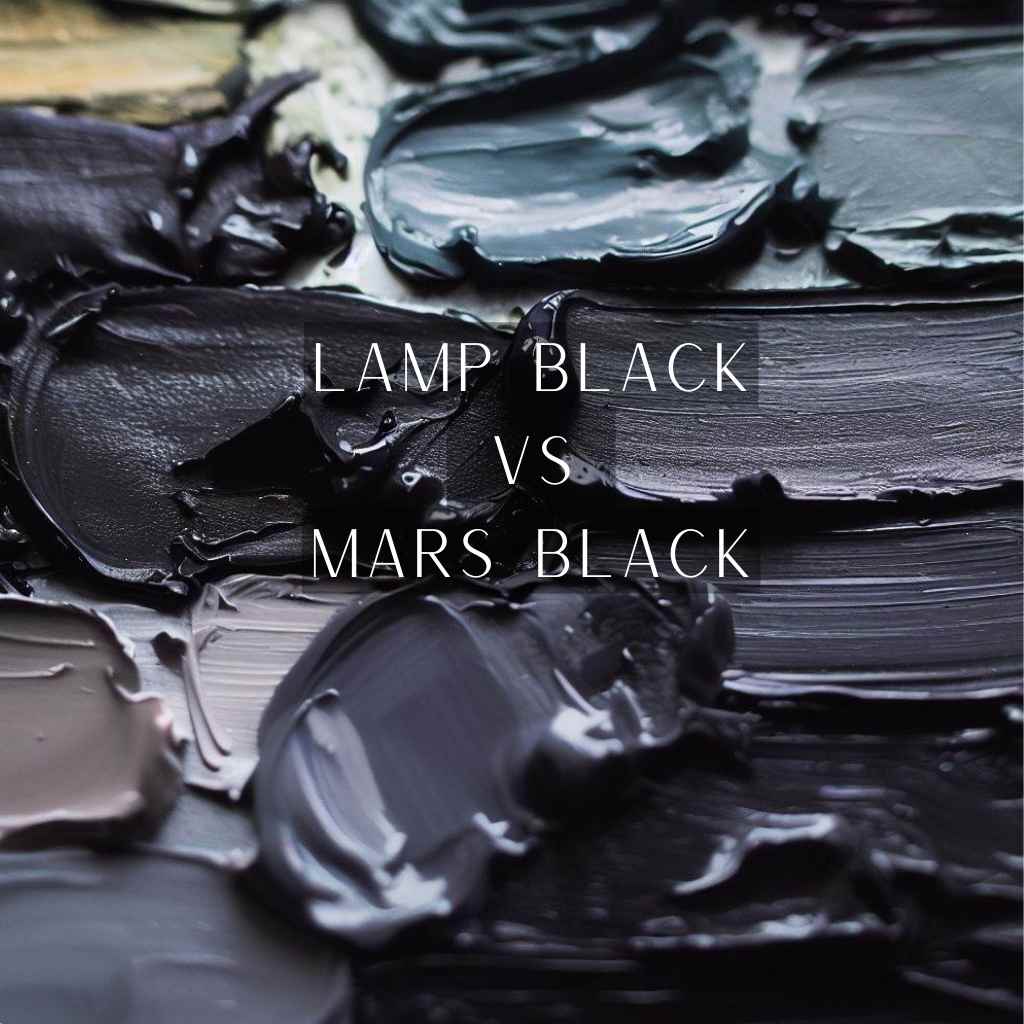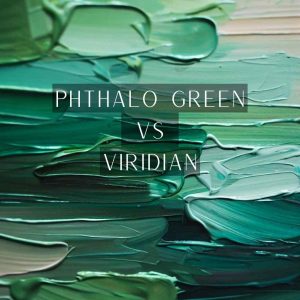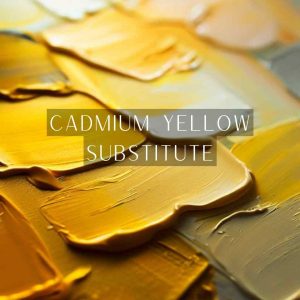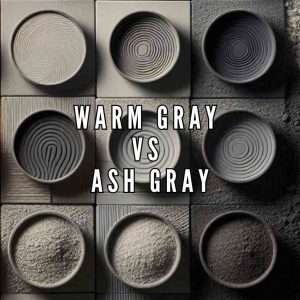In the mesmerizing realm of artistic expression, where colors collide and emotions entwine, a timeless rivalry brew – lamp black vs. Mars black.
These two enigmatic pigments, both drenched in the deepest shades of darkness, stand at the crossroads of artistic creation, beckoning creators to choose their side.
As you delve into the layers of this intriguing contest, prepare to witness a symphony of contrasts, to be entangled in the nuances of texture and depth, and to grasp the profound impact a mere pigment can wield.
Lamp Black: The Classic Charcoal
Lamp black, a pigment with roots tracing back to antiquity, finds its origin in the charring of organic materials like wood or oil.
Used by ancient civilizations to create ink and portray depth, lamp black carries a rich historical significance that connects us to the artistic traditions of the past.
The process of creating lamp black is a delicate dance between fire and organic matter. By carefully controlling the combustion of materials like oil or wood, artists produce a velvety black pigment that captures the essence of darkness. This meticulous process gives lamp black its unique character and texture.
Mars Black: The Iron-Based Shade
Unlike lamp black, Mars black emerged as a synthetic pigment, owing its existence to human ingenuity.
Developed as an alternative to traditional iron-based black pigments, Mars black revolutionized the art world with its consistent properties and availability.
Mars black is a product of modern chemistry, synthesized through controlled chemical reactions. By transforming iron oxides under specific conditions, artists can achieve a reliable and reproducible pigment that offers unique advantages.
Lamp Black vs Mars Black: Visual Comparison
Among the array of blacks, two contenders have captivated the artistic realm for centuries: lamp black and Mars black.
Here is the comparison between two black contenders-
Depth, Opacity, and Texture
At first glance, lamp black and Mars black might appear strikingly similar, both radiating the depth and darkness that the color embodies. However, upon closer examination, subtle nuances in hue and texture reveal themselves.
Lamp black’s depth and opacity lend a sense of richness to artworks, while its texture allows for various application techniques. It boasts a velvety appearance. From subtle shadows to bold contrasts, lamp black offers a versatile range that enriches artistic expressions.
Mars black’s slightly warm hue and inherent transparency set it apart from other black pigments. This transparency allows for intriguing layering effects, enhancing its adaptability to various artistic styles.
Lightfastness and Durability
The passing of time can be unkind to art, slowly erasing the brilliance and vibrancy that once graced the canvas. Lightfastness—the pigment’s resistance to fading when exposed to light—is an essential trait in ensuring an artwork’s enduring beauty.
Here, both lamp black and Mars black stand as staunch sentinels, promising that the depth they bring to an artwork will remain steadfast for generations to come. This unwavering resilience ensures that the emotional impact an artist intends remains as poignant as the day it was first unveiled, preserving the essence of the artist’s intent.
Mixing with Other Colors
Black isn’t just a solitary shade; it’s the anchor that elevates other colors. Both lamp black and Mars black possess the unique ability to harmonize with a diverse spectrum of hues.
When mixed with other colors, they contribute to a stunning array of shades and tints, whether it’s for subtle transitions or striking contrasts. This versatility transforms them into indispensable tools in an artist’s arsenal, enhancing the range of creative possibilities.
The Emotional Impact
Colors possess an innate ability to evoke emotions, and black is a master at invoking the deepest sentiments within us. Both lamp black and Mars black are not mere shades; they are carriers of psychological associations that transcend their visual presence.
Lamp black conveys a sense of enigmatic mystery, elegance, and depth, making it a symbol of power and intrigue.
Mars black, with its slightly warmer undertones, adds a touch of warmth to its darkness, inviting viewers to explore its depths with a sense of curiosity. Harnessing these emotional resonances, artists can craft compositions that captivate and connect on a profound level, letting color communicate the unspoken.
Lamp Black vs Mars Black: Artistic Applications
The shades of black hold a distinctive allure, offering depth, contrast, and a sense of mystery to artworks.
Here is how lamp black and Mars black – two captivating black pigments – find their unique places in various mediums, each contributing to the symphony of visual storytelling-
- Depths with Lamp Blacki in Oil Painting: Lamp black, with its velvety texture, takes center stage in the world of oil painting. Its depth and richness allow artists to craft captivating shadows, adding a sense of three-dimensionality to their compositions.
Lamp black is a key player in creating dramatic chiaroscuro effects, enhancing the contrast between light and shadow.
Artists utilize this pigment to infuse landscapes with moody atmospheres and evoke powerful emotions through the interplay of light and dark.
- Mars Black for Dynamic Contrast in Acrylic Painting: Mars black finds its stride in the realm of acrylic painting, contributing to striking contrasts and vibrant highlights. Its transparency makes it an excellent choice for layering, enabling artists to build complex color interactions while maintaining luminosity.
The unique warmth of Mars black infuses energy and character into acrylic compositions, enhancing their visual impact. Acrylic artists leverage Mars black to create dynamic textures, striking a balance between transparency and depth.
- Subtle Layering with Mars Black in Watercolor Techniques: Mars black’s transparency and granular texture make it a valuable asset in watercolor techniques.
Artists employ Mars black to layer delicate washes, infusing their works with a sense of depth and atmospheric realism. Its ability to blend seamlessly with other watercolors allows for the creation of nuanced gradients and soft transitions.
By using diluted Mars black, artists achieve delicate tonal shifts that evoke distance, mood, and emotion in their watercolor artworks.
- Lamp Black in Printmaking: In the world of printmaking, lamp black takes on the role of bold expression and captivating contrast.
The intense depth of the lamp black contributes to a strong visual impact, particularly in techniques like etching and engraving. Printmakers leverage the richness of lamp black to create intricate textures, shadows, and layers in their prints.
The juxtaposition of light and dark, made possible by the lamp black, adds drama and intrigue to the visual narrative of printmaking.
- Combining Both Blacks in Mixed Media Art: In mixed media art, the interplay between lamp black and Mars black opens doors to a world of visual drama and complexity. Combining lamp black’s depth with Mars black’s transparency creates a harmonious contrast that adds depth to compositions.
Artists blend these blacks to create layered textures, captivating visual narratives, and a fusion of traditional and contemporary aesthetics.
The synergy between these two pigments in mixed media art results in eclectic, multidimensional artworks that invite viewers to explore and interpret.
FAQs
- Can lamp black and Mars black be used for portraiture?
Yes, both pigments can be utilized in portraiture. Lamp black can contribute to rich shadows and depth in portraits, enhancing the three-dimensionality of the subject. Mars black’s warmth can be particularly effective in creating lifelike skin tones and adding a touch of character to the portrait.
- Can lamp black and Mars black be used for abstract expressionism?
Certainly. Abstract expressionism thrives on the emotional and visual impact of colors and forms. Lamp black’s depth and Mars black’s versatility can be harnessed by abstract expressionists to create dynamic compositions that evoke intense emotions and engage the viewer’s imagination.
- Are there any conservation considerations when using lamp black and Mars black pigment?
When using lamp black and Mars black, artists should be mindful of proper conservation practices to ensure the longevity of their artworks. This includes using high-quality materials, proper framing techniques, and ensuring the pigments are applied in a stable manner.
- Can lamp black and Mars black be used to create architectural renderings?
Certainly. Both pigments can find a place in architectural renderings, adding depth, shadows, and contrast to the structures portrayed. Lamp black and Mars black can enhance the realism and visual impact of architectural illustrations.
- How do lamp black and mars black interact with different painting mediums and surfaces?
Lamp black and Mars black can interact differently with various painting mediums and surfaces. It’s advisable for artists to experiment with these pigments on different substrates and mediums to understand how their unique characteristics manifest in each context.
- Can lamp black and Mars black be used to create architectural renderings?
Certainly. Both pigments can find a place in architectural renderings, adding depth, shadows, and contrast to the structures portrayed. Lamp black and Mars black can enhance the realism and visual impact of architectural illustrations.
- How do lamp black and Mars black pigment interact with different painting mediums and surfaces?
Lamp black and Mars black can interact differently with various painting mediums and surfaces. It’s advisable for artists to experiment with these pigments on different substrates and mediums to understand how their unique characteristics manifest in each context.
- Can artists use lamp black and Mars black to create a focal point in their compositions?
Certainly. The depth and intensity of these pigments can be harnessed to create focal points in artworks. By strategically placing lamp black or Mars black in areas of high contrast, artists can draw the viewer’s attention and guide their gaze within the composition.
Wrapping Up
As we unfurl the final canvas of this artistic duel – lamp black vs Mars black – we find ourselves immersed in a symphony of contrasts and harmonies, a dance of textures and emotions that have painted a vivid narrative across each stroke.
The journey through the depths of these two pigments has not been a mere exploration of hues, but an excavation of artistic identity. With every brushstroke, every layer, and every emotion layered upon the canvas, the choice between these blacks has materialized as a mirror reflecting our creative essence.
Now, as the tale of lamp black and Mars Black culminates, you stand at the crossroads of a decision – a decision that transcends pigments, hues, and depths. As you venture forth, remember that the canvas, like life, is yours to enrich with the shades of your imagination.




